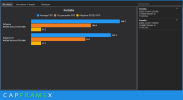davis.anthony
Veteran
Doesnt work like that. Metro Exodus EE gets 60 FPS on consoles with proper hardware Raytracing.
I think it's important to highlight that Metro:EE is still, at heart, a game that targets last generation consoles.
If UE5 could run on last gen consoles it would be much more performant on current consoles than it is.
It's also worth pointing out that on PS5 and XSX the game cam drop below 1080p and has things like tessellation disabled.
So it's not that much of a technical fest as it is being made to be as I image a lot of last gen games could be done at 1080p60 with RTGI as they lack any next generation effects.


